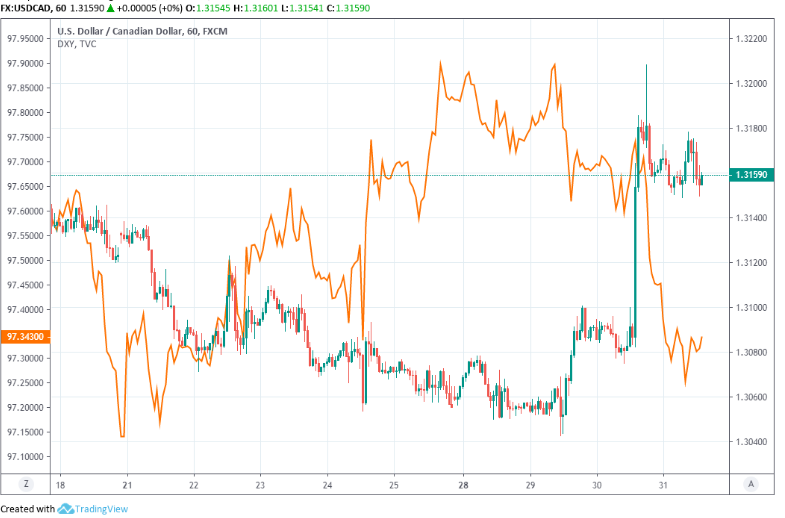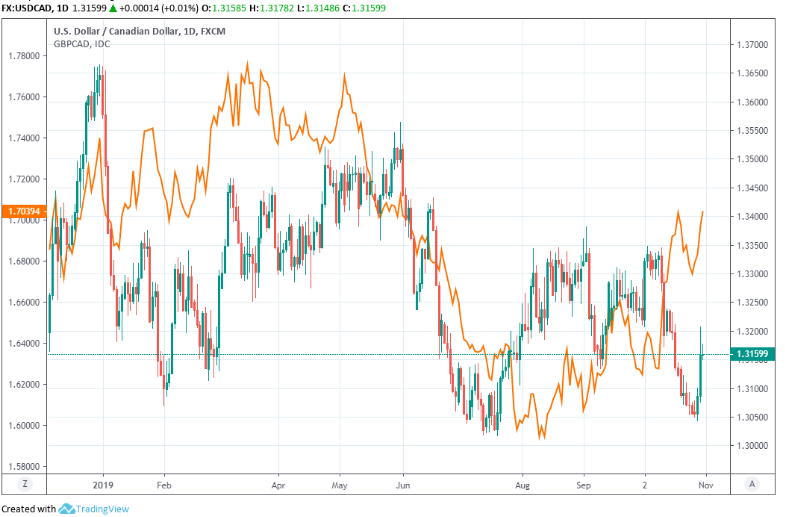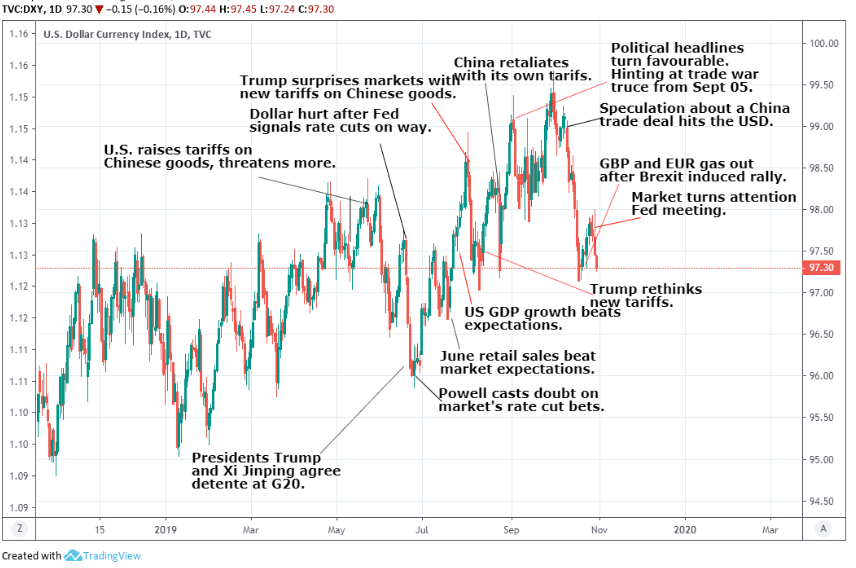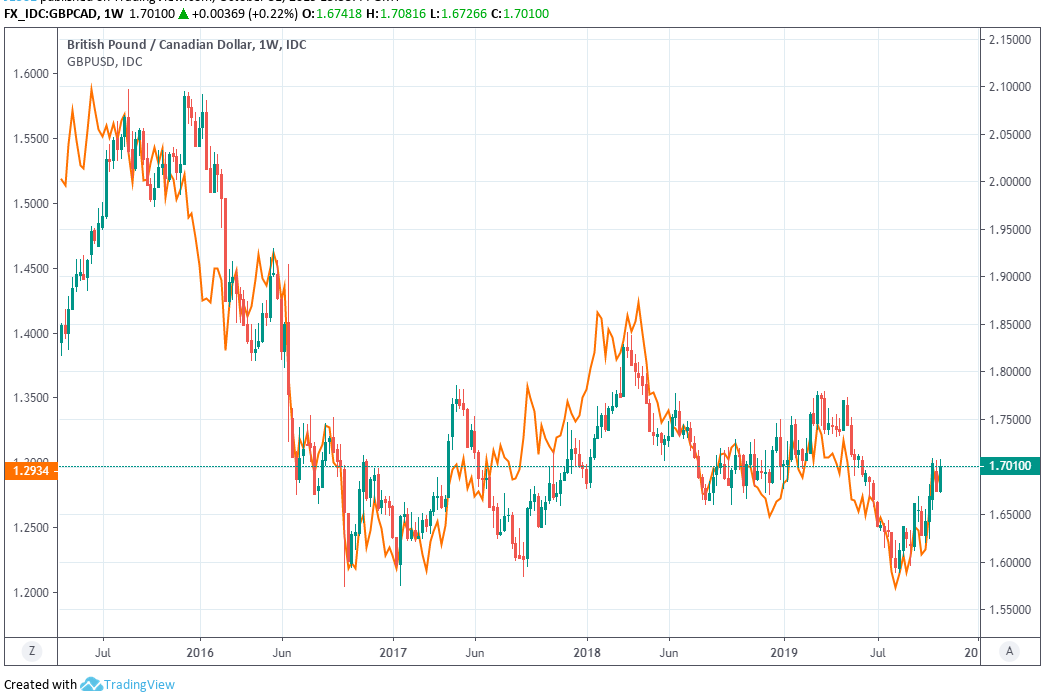The Canadian Dollar Claws Back Lost Ground Even as Economy Disappoints
- Written by: James Skinner
-

Image © Adobe Stock
- CAD stabilises despite GDP miss, U.S.-China unease.
- Economy grows 0.1% in August, disappointing market.
- Further disappointment would threaten BoC's forecasts.
- Fed drives CAD recovery of lost ground from wobbly USD.
- But analyst views on outlook for CAD and USD differ wildly.
- GBP/CAD rising with odds of Conservative election victory.
The Canadian Dollar stabilised Thursday despite after growth figures surprising on the downside for August and amid mounting fears for the U.S.-China trade ceasefire, after a third 2019 interest rate rate cut from the Federal Reserve (Fed) enabled the Loonie to claw back ground previously lost to its U.S. rival.
Canada's Dollar was a fraction higher against a wobbly U.S. greenback Thursday and won fresh ground from all of its major rivals other than Pound Sterling and safe-havens like the Yen and Swiss Franc, even after the Bank of Canada (BoC) hinted on Wednesday that an interest rate cut could be in the pipeline and despite Statistics Canada revealing on Thursday that the economy saw a soft start to the third quarter.
"This month's weakness could be blamed on a fall in wholesaling, and disruption in energy output on the east cost (as well as softer oil sand output), and manufacturing was a winner this month but will see the impact of the GM strike ahead, and is only flat from a year ago. While the Bank of Canada is anticipating a mediocre Q4 as well, there's room to undershoot their call if monthly growth continues to oscillate between 0.0 and 0.1%," says Avery Shenfeld, chief economist at CIBC Capital Markets.
The economy grew by 0.1% in August, according to Statistics Canada, up from 0% in July but below the consensus for a 0.2% expansion. That sets Canada up for a soft third quarter and has prompted questions of whether growth in the final months of the year will be enough to meet BoC forecasts. If it begins to look as if it won't be, the rate cut that was floated on Wednesday could come sooner than even the more 'dovish' voices in the market envisage.

Above: USD/CAD rate shown at hourly intervals, alongside Pound-to-Canadian-Dollar rate (orange line, left axis).
"The BoC looks to have become a little less comfortable with standing out from other central banks and took the opportunity to rein back that divergence by encouraging some renewed speculation of monetary easing," says Fritz Louw, a currency analyst at MUFG. "The BoC explicitly highlighted that the loonie had strengthened against other currencies even as commodity prices have fallen amid concerns over global demand. Taken together the BoC left us with the impression that they wanted to dampen Canadian dollar strength and were wary of it strengthening further on the back of the higher yields on offer in Canada. This bearish turning point for the Canadian dollar should see weakness extend further over the short-term."
Canada's central bank abandoned on Wednesday its oft repeated claim that the current level of interest rates is "appropriate", and warned instead that the economy's resilience will be "tested" by trade conflicts and uncertainty over the global growth outlook in the months ahead. The policy update crushed the Canadian Dollar because it was seen as a clear indication the BoC intends to follow the Fed and other central banks by cutting rates in order to protect the economy from an ongoing global slowdown.
Changes in interest rates are normally only made in response to movements in inflation, which is sensitive to growth, but impact currencies because of the push and pull influence they have over capital flows. Capital flows tend to move in the direction of the most advantageous or improving returns, with a threat of lower rates normally seeing investors driven out of and deterred away from a currency. Rising rates have the opposite effect.
"We maintain our view that the USDCAD will close out the year at the $1.30 barrier as Canada’s domestic economic data remains resilient, but the shift in market sentiment around the Canadian dollar following [Wednesday's] rate decision increases the downside risks to this view," says Simon Harvey, an analyst at Monex Europe. "The time frame is too short for the upcoming data to show enough of a widespread downturn in economic conditions to warrant such an immediate cut. If anything, the sharp depreciation of the loonie following the announcement increases our assessment that an insurance rate cut by the BoC is forthcoming this year."

Above: USD/CAD rate shown at daily intervals, alongside Pound-to-Canadian-Dollar rate (orange line, left axis).
Thursday's stabilisation by the Loonie came in response to the Fed having scrapped and melted down its interest rate advantage over other major currencies including the Canadian Dollar. It also came in spite of fresh concerns over the longevity of the October 11 trade war ceasefire struck between the U.S. and China, as well as in the face of losses for stock markets and oil prices, all of which are key drivers for the Canadian currency.
"The BoC's dovish pivot reinforces CAD's vulnerability - particularly on some key G10 crosses. Until recently, the loonie has acted a bit like a baby USD. It has offered positive carry alongside a less volatile growth story. This has largely insulated it amid the recent market shocks. CAD's positive factors have started to ease, however," says Ned Rumpeltin, European head of FX strategy at TD Securities. "The FOMC's guidance clearly set the bar higher for additional accommodation, with "monetary policy is in a good place"...We think the USD should recalibrate tactically higher over time – despite the market’s initial reaction to the decision. At its core, the USD remains the high yielder in the G10FX complex. Meanwhile, the outlook for global growth remains murky."
....our manufacturers. We should have lower interest rates than Germany, Japan and all others. We are now, by far, the biggest and strongest Country, but the Fed puts us at a competitive disadvantage. China is not our problem, the Federal Reserve is! We will win anyway.
— Donald J. Trump (@realDonaldTrump) October 31, 2019
The Fed cut its interest rate so that it's on a par with the 1.75% level of the BoC on Wednesday but Chairman Jerome Powell said it would take a "material reassessment" of the outlook for any further policy changes to become appropriate. The Fed had already effectively told markets that it's done cutting U.S. rates by deleting from its regular statement, the line claiming it'll "act as appropriate to sustain the expansion."

Above: Dollar index shown at daily intervals.
Chinese officials are said to be unwilling to entertain the structural reforms the U.S. is seeking in pursuit of a 'phase two' accord, which is necessary to end the trade war between the world's two largest economies that has wrought havoc on commodity currencies since early 2018, unless the White House drops the tariffs on the nation's exports to the U.S. They are said to doubt that it would be possible to reach such an agreement.
China and the USA are working on selecting a new site for signing of Phase One of Trade Agreement, about 60% of total deal, after APEC in Chile was canceled do to unrelated circumstances. The new location will be announced soon. President Xi and President Trump will do signing!
— Donald J. Trump (@realDonaldTrump) October 31, 2019
An uneasy truce between the U.S. and China has lifted the Aussie and other risk sensitive currencies since an October 11 agreement averted an increase in U.S. tariffs that was planned for mid-month. But President Donald Trump already announced in August and September that new levies will hit all of China's remaining exports to the U.S. from December 15 and those tariffs are still due to go on if further progress in the negotiations is not made.
"The Brexit Party has reportedly opted to run in just 20-30 seats nationwide, rather than hundreds of seats as some had previously speculated. On the face of it, that's good for the Conservatives, as it means there is less chance of the Brexit Party splitting the Leave vote across the UK. The Brexit Party remains as potent as ever, and may only need 10 seats in the House of Commons to be able to hold the balance of power. A future Conservative prime minister may well have to rely on those votes to pass Brexit legislation – and Brexit Party MPs will be intransigent. The Brexit Party will announce its intentions on Friday," says Matthew Cowley, a macro salesperson at UBS.

Above: Pound-to-Canadian-Dollar rate shown at weekly intervals alongside GBP/USD rate (orange line, left axis).
For the time being, the global market tide is showing signs of turning against the U.S. Dollar and the Canadian Dollar appears to have dodged a proverbial bullet at least as far as its U.S. rival is concerned. Pound Sterling, on the other hand, is a different story because the British currency was boosted on Thursday by improving odds among the bookmakers in favour of a Conservative Party victory in the December 12 general election.
That's boosted the Pound because it also improves the odds of the UK both avoiding a 'no deal' Brexit but also moving further along the path toward an agreed future relationship with the EU. For all its flaws, Prime Minister Boris Johnson's exit agreement is seen decisively ending the threat of a 'no deal' Brexit while providing some kind of certainty to businesses about the UK's trade arrangements for at least a couple of years. However, some have pointed out there's a flip side to Thursday's developments.
"The GBP has found good bids on weakness to the low 1.67 area over the past couple of sessions as markets fade the GBP slide. We spot key support at 1.6690, the Sep high, and would anticipate additional, corrective GBP weakness below here," says Juan Maneul Herrera, a strategist at Scotiabank, referring to the Pound-to-Canadian-Dollar rate in a recent note to clients. "Longer run charts are turning more supportive and daily and weekly trend strength signals are still GBP-supportive. We expect renewed GBP weakness to the 1.66 range in the next few weeks to continue to draw out GBP buyers."
Time to move your money? Get 3-5% more currency than your bank would offer by using the services of a specialist foreign exchange specialist. A payments provider can deliver you an exchange rate closer to the real market rate than your bank would, thereby saving you substantial quantities of currency. Find out more here.
* Advertisement









